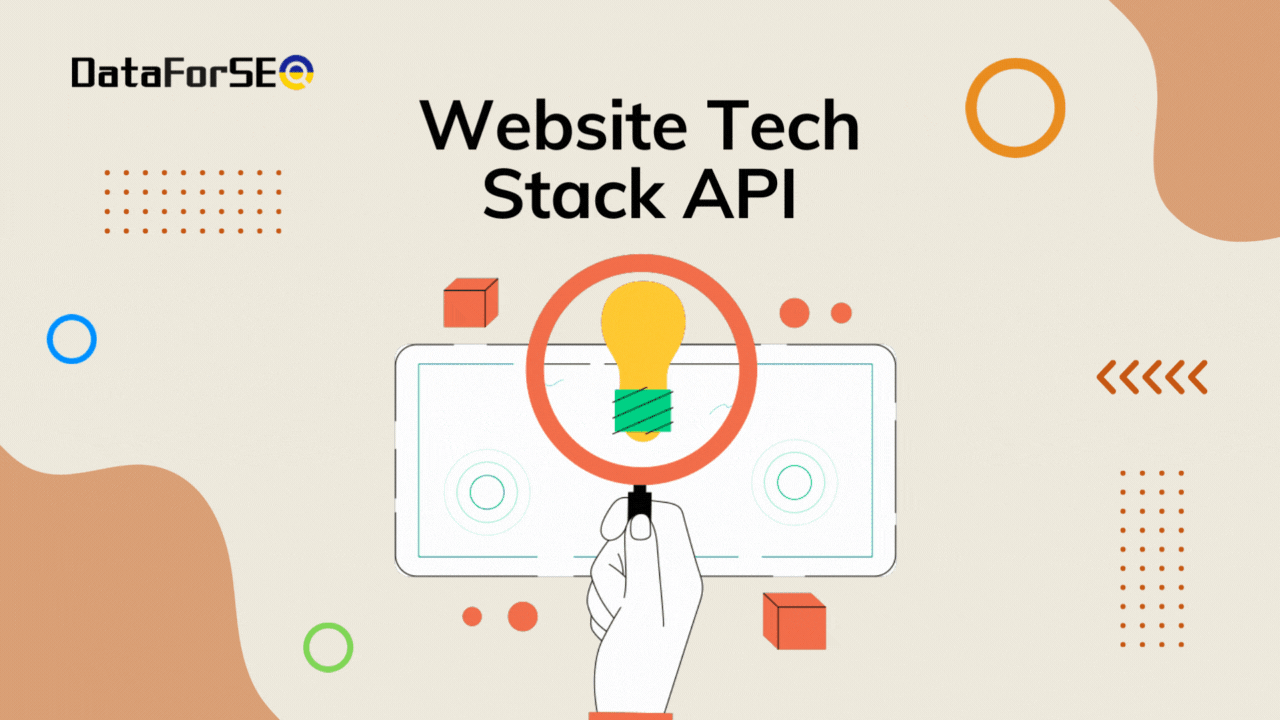
Uncover Website Technologies With Domain Analytics API
The web technology landscape is evolving extremely fast. In 2022, the MarTech volume alone has reached a whopping 9,932 solutions, up 24% from 2020 and up 5,233% over a 10-year period.
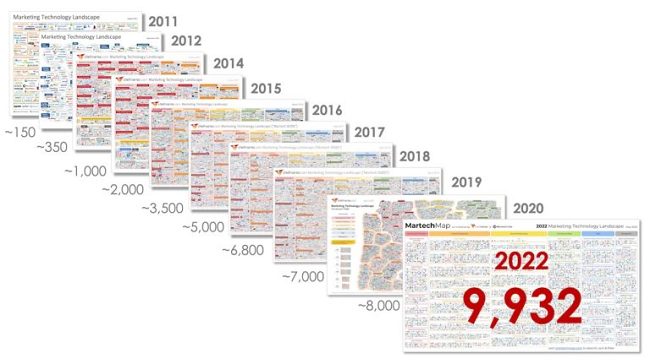
Such a dynamic and swarming environment brings both challenges and opportunities for product and service providers in the industry. On the one hand, it becomes extremely difficult to differentiate. On the other hand, this environment generates a rich abundance of data on web technologies that websites use.
This information is called technographic data and it helps enterprises accelerate prospects discovery, boost B2B sales, and identify potential new markets.
In this piece, we’ll help you unscramble the following questions:
What’s technographic data, and how does it impact businesses?
How to collect technographic data?
What’s a technology lookup API and what does it do?
How to use DataForSEO APIs to identify a website’s tech stack?
What’s a technology profiler tool and how to build one with API?
What’s technographic data, and how does it impact businesses?
Technographic data is a collection of information about software and hardware technologies used on various websites. In its turn, technographic segmentation or technographics (from “technology” and “demographics”) is a market research methodology that helps to spot trends and to evaluate the adoption rate of certain solutions at scale.
In other words, technographic data allows you to explore the web tech landscape and a particular tech stack powering a website you’re interested in.
While the technology itself is power, data is leverage.
Every business is harnessing the power of different technologies in the ways most beneficial for their revenue growth. At the same time, technographic data on different businesses provides deep insights into their technology purchasing trends, their workflows, and even the issues they are looking to resolve. Having access to these insights can give you significant leverage over companies that don’t use technographic data in their marketing and research activities.
Imagine you’re selling cars and your competitors are getting more sales because their car is faster, and consumes less fuel. To enhance your product, you’d want to get a close look under the hood of your competitor’s car and examine the technologies used in it.
Basically, this is what technographic data allows you to do but in the scope of web technologies that your competitors are using. For example, if you were an e-commerce brand, you could discover that your competitors are using cart abandonment solutions while you’re not, and this could be the reason why you’re getting fewer completed purchases.
Another common application of technographic data is market research. By reviewing the adoption rate of certain applications at scale, you can compare market shares and estimate usage trends to prepare niche forecasts and plan your company’s next strategic move.
Besides market research and competitor analysis, technographic data can be your leverage for finding and converting prospects faster and easier. In particular, you can:
- Find companies that fit your service segmented by their website tech stack.
- Discover prospects that use competitors’ software.
- Determine a prospect’s level of technical expertise and budget for tech solutions.
Competitor analysis, market research, and prospect profiling for ABM (account-based marketing) are just a few most common examples of practical technographic data application. Some businesses have unique use cases where information on the website’s tech solutions provides key insights. In any case, the value of technographic data in the current digital landscape is undeniable and is certainly a must for elevating a company’s performance.
Now that you know what benefits technographic data offers for various businesses, let us explain how you can get this data.
How to collect technographic data?
In short, there are three ways to obtain technographic data:
- Ask
- Scrape
- Buy
The first method might be the most obvious, yet not the most reliable and efficient. On the one hand, if you have a question about a company, why not just call or email and ask? On the other hand, if you do, you will find out that companies are typically reluctant to respond to cold calls or email surveys, and there is no guarantee that you’ll be asking the right person who can provide up-to-date and accurate information about the tech stack on their site.
This brings us to method number two. A company’s website is another direct source of valuable technographic data. Getting data from a website’s source code is more reliable and efficient than the first solution, yet it has disadvantages too. First off, to access data on a number of websites, you need to scrape it with the help of a web scraping tool. Working with this tool requires some level of coding and technical expertise. In particular, you need to ensure the tool will collect only relevant data and will not violate website policies and legislation.
Given the low efficiency and reliability of the first method and the complexities of the second one, most companies go with the third option, which is purchasing data from a third-party provider. It is the most hassle-free way to obtain clean and accurate data.
Keep in mind that before making a purchase, you need to make sure the data provider you’re considering has a good reputation, offers the needed volumes, and regularly updates data. Also, check if the provider of your choosing offers data delivery that suits your needs.
Generally, when looking to buy technographic data, you can choose one of three forms of data delivery: a dataset, a database, or via API.
If you need a small portion of data, a dataset should suffice, yet you need to consider if it offers all the data points you’re interested in. For large projects, a database should fit better as it encompasses multiple datasets and allows for large-scale analysis. Yet, it may offer numerous unnecessary data points you’ll be essentially overpaying for. Besides that, database updates usually take considerable time and have to be purchased separately.
In case your analytical needs are in flux, or you feel that a dataset is limiting you and a database is too costly, there’s also a technology lookup API. Using this solution, you can gain flexible access to technographic data and you don’t necessarily have to understand coding. The benefits of using APIs for technology profiling also include scalability, lower cost compared to paid off-the-shelf tools, and greater possibilities for data blending.
We’ll tell you more about technology lookup APIs in the next part.
What’s a technology lookup API and what does it do?
Technology lookup API is a solution for obtaining data on the web technologies used by various websites across the Internet.
The term API (application programming interface) refers to a set of codes and protocols that create a possibility for seamless data transmission between two different software applications. Basically, API is acting as an intermediary between the app where you’re requesting some data and the database where it reaches to pull the data into your app.

Most technology lookup APIs are REST APIs, meaning that they follow the Representational State Transfer guidelines. So, once you request a resource, the server will transfer back the resource’s current state (up-to-date data on a site’s technologies) in a standardized representation, typically in JSON (JavaScript Object Notation).
Now, let’s take a look at the steps needed to access data via an API call:
- Sign up with a provider
- Obtain an API key (kinda password)
- Review API documentation (to learn how to use a particular API and compose requests)
- Get an API testing tool (such as Postman which has a free version)
- Compose an API request to an endpoint (a URL indicated in the provider’s docs)
- Receive data in the response or make a separate GET request to retrieve it
- Integrate an API with your system or app
One of the most valuable things about API is that it can be integrated with virtually any app, from in-house software or database to reporting tools like Google Data Studio and Power BI, or tools like Google Sheets through certain scripts. You can use technology lookup APIs to empower your website or software with technology lookups or to compile a list of websites that use a certain technology, such as a particular CMS. We’ll give you an actionable example in the following part.
How to use DataForSEO APIs to identify a website’s tech stack?
At DataForSEO, we offer a dedicated API for technology profiling – Domain Technologies API. It is a part of a broader group of our products – Domain Analytics API, which encompasses the endpoints of Domain Technologies API and Whois API.
Domain Technologies API is designed to help you identify all possible technologies that power certain websites.
To determine what technologies are used on a site, Domain Technologies API scans its source code, HTTP headers, cookies, JavaScript variables, and other parts of HTML code.
Domain Technologies API is a new DataForSEO product, yet it already offers wide coverage of technographic data, and the volume is constantly growing. Currently, our database contains 36 million domains and 2,460 technologies, and all data is updated every 30 days.
The pricing of DataForSEO Technologies API is also designed to fit projects of all sizes, as you will only pay for the data you use without any monthly subscriptions. You can review all the details and estimate the cost of using Technologies API on our pricing page.
Using Domain Technologies API, you can review stats by domain and by technology name, category, or group. You can apply custom filtration, and set different types of storing to receive a dataset that’d be most valuable for you and arranged most appropriately for your analytical needs.
DataForSEO’s Technologies API operates in the Live mode, that is, you will obtain data in response to one POST request, without having to make a separate GET request.
When working with the Domain Technologies API, you will be making API calls to endpoints. An endpoint is a location represented by a URL from which API can access the requested data. You can think of an endpoint as a storage cell that needs to be opened to pull out specific data.
Domain Technologies API offers you four endpoints to obtain the following:
• Domain Technologies – a list of technologies used by a particular domain.
• Domains by Technology – domains based on the technology they use.
• Aggregation Technologies – a list of technologies often used alongside the ones you specify.
• Technologies Summary – number of domains across different countries and languages that use the specified technologies.
If your project requires blending website tech stack data with Whois information and backlink stats, you can obtain all of the above through Whois endpoints of Domain Analytics API.
Now, let’s say, you’re planning to build a WordPress website for your new SaaS project targeted at the US. Before reaching out to a development service, you want to take a look at some industry-leading sites built with WordPress, review their themes and understand how they are making their websites more convenient for their users.
To obtain a list of such websites, you can make a call to the Domain Technologies API.
Before proceeding with the steps below, don’t forget to create a free trial account with DataForSEO and obtain your API key from our Dashboard.
1 To make an API call, use the following POST endpoint which can be found in our docs:
2 Here’s a code you can use in Postman to request data on 10 US websites with Domain Rank over 800 that use WordPress.
[
{
"technologies": [ "WordPress"],
"filters":[
[
"country_iso_code",
"=",
"US"
],
"and",
[
"domain_rank",
">",
800
]],
"order_by": ["domain_rank,desc"],
"limit": 3
}
]
3 Once you specify the desired parameters and send a request, the API reaches our server, our system pulls the requested data from our database and the API delivers it straight to you in JSON format. Here’s the response to our request.
{
"version": "0.1.20220819",
"status_code": 20000,
"status_message": "Ok.",
"time": "1.4301 sec.",
"cost": 0.013,
"tasks_count": 1,
"tasks_error": 0,
"tasks": [
{
"id": "10261343-1535-0484-0000-f8cba7fcf1fd",
"status_code": 20000,
"status_message": "Ok.",
"time": "1.2645 sec.",
"cost": 0.013,
"result_count": 1,
"path": [
"v3",
"domain_analytics",
"technologies",
"domains_by_technology",
"live"
],
"data": {
"api": "domain_analytics",
"function": "domains_by_technology",
"se": "technologies",
"technologies": [
"WordPress"
],
"filters": [
[
"country_iso_code",
"=",
"US"
],
"and",
[
"domain_rank",
">",
800
]
],
"order_by": [
"domain_rank,desc"
],
"limit": 3
},
"result": [
{
"total_count": 11,
"items_count": 3,
"offset": 0,
"offset_token": "eyJDdXJyZW50T2Zmc2V0IjozLCJSYXdSZXF1ZXN0Ijp7Im9yZGVyX2J5Ijp7Im9yZGVyX2ZpZWxkIjoiZG9tYWluX3JhbmsiLCJvcmRlcl90eXBlIjoiZGVzYyJ9LCJsaW1pdCI6Mywib2Zmc2V0IjowLCJ0ZWNobm9sb2dpZXMiOlsiV29yZFByZXNzIl0sInF1ZXJ5Ijp7InR5cGUiOiJhbmQiLCJsZWZ0Ijp7ImZpZWxkIjoiY291bnRyeSIsInR5cGUiOiJlcSIsInZhbHVlIjoiVVMifSwicmlnaHQiOnsiZmllbGQiOiJkb21haW5fcmFuayIsInR5cGUiOiJndCIsInZhbHVlIjo4MDB9fX0sIlNlYXJjaEFmdGVyRGF0YSI6eyJWZXJzaW9uIjoxLCJTZWFyY2hBZnRlclZhbHVlcyI6eyJkb21haW5fcmFuayI6NzQyMTc3NDQwMDAwLjAsIl9zY29yZSI6Ni4yNTkwNTA0LCJkb21haW5faGFzaCI6LTUuMjk5MjgwNUUrMTh9LCJUb2tlblJlYWxPZmZzZXQiOjB9fQ==",
"items": [
{
"type": "domain_technology_item",
"domain": "github.blog",
"title": "The GitHub Blog | Updates, ideas, and inspiration from GitHub to help developers build and design software.",
"description": "Updates, ideas, and inspiration from GitHub to help developers build and design software.",
"meta_keywords": null,
"domain_rank": 929,
"last_visited": "2022-10-22 20:50:38 +00:00",
"country_iso_code": "US",
"language_code": "en",
"content_language_code": "en",
"phone_numbers": null,
"emails": null,
"social_graph_urls": [
"https://github.blog/",
"@github"
],
"technologies": {
"content": {
"cms": [
"WordPress"
],
"blogs": [
"WordPress"
]
},
"servers": {
"web_servers": [
"Nginx"
],
"reverse_proxies": [
"Nginx"
],
"databases": [
"MySQL"
]
},
"marketing": {
"seo": [
"Yoast SEO",
"Yoast SEO Premium"
]
},
"add_ons": {
"wordpress_plugins": [
"Yoast SEO"
]
},
"web_development": {
"programming_languages": [
"PHP"
]
}
}
},
{
"type": "domain_technology_item",
"domain": "themegrill.com",
"title": "Premium WordPress Themes & Templates by ThemeGrill - 400K+ Users",
"description": "DOWNLOAD NOW! Best professional responsive WordPress themes and templates of 2021. Suitable for business, magazine, portfolio, blogging & any kind of sites.",
"meta_keywords": null,
"domain_rank": 916,
"last_visited": "2022-10-20 15:28:52 +00:00",
"country_iso_code": "US",
"language_code": "en",
"content_language_code": "en",
"phone_numbers": null,
"emails": null,
"social_graph_urls": [
"https://themegrill.com",
"@themegrill"
],
"technologies": {
"servers": {
"caching": [
"WP Rocket"
],
"web_servers": [
"Nginx"
],
"reverse_proxies": [
"Nginx"
],
"databases": [
"MySQL"
]
},
"add_ons": {
"wordpress_plugins": [
"WP Rocket",
"MailChimp for WordPress"
],
"wordpress_themes": [
"Zakra"
]
},
"content": {
"cms": [
"WordPress"
],
"blogs": [
"WordPress"
]
},
"web_development": {
"page_builders": [
"Elementor"
],
"javascript_libraries": [
"jQuery",
"jQuery Migrate",
"Swiper"
],
"font_scripts": [
"Google Font API",
"Font Awesome"
],
"programming_languages": [
"PHP"
]
},
"marketing": {
"marketing_automation": [
"MailChimp for WordPress",
"MailChimp"
],
"email": [
"MailChimp"
]
},
"analytics": {
"analytics": [
"Google Analytics"
]
},
"communication": {
"live_chat": [
"Crisp Live Chat"
],
"email": [
"MailChimp"
]
},
"business_tools": {
"live_chat": [
"Crisp Live Chat"
]
}
}
},
{
"type": "domain_technology_item",
"domain": "wordpress.com",
"title": "WordPress.com: Schnelles, sicheres verwaltetes Hosting von WordPress",
"description": "Erstelle auf WordPress.com bequem eine kostenlose Website oder ein Blog. Dutzende kostenlose, anpassbare, mobilfreundliche Designs und Themes. Hosting und Support sind kostenlos.",
"meta_keywords": null,
"domain_rank": 906,
"last_visited": "2022-10-22 08:41:36 +00:00",
"country_iso_code": "US",
"language_code": "de",
"content_language_code": "de",
"phone_numbers": null,
"emails": null,
"social_graph_urls": [
"https://wordpress.com/de/",
"@wordpressdotcom"
],
"technologies": {
"content": {
"cms": [
"WordPress"
],
"blogs": [
"WordPress"
]
},
"servers": {
"paas": [
"WordPress.com"
],
"web_servers": [
"Nginx"
],
"reverse_proxies": [
"Nginx"
],
"databases": [
"MySQL"
]
},
"web_development": {
"font_scripts": [
"Google Font API"
],
"programming_languages": [
"PHP"
]
}
}
}
]
}
]
}
]
}
That fast and simple, we’ve just pulled out the necessary list of websites.
Besides this use case, you can leverage DataForSEO Technologies API for virtually any technology profiling task or large-scale tech market analysis. You can also apply this API to create a lead generation landing with tech lookups on your site, or to develop a full-fledged technology profiling tool.
What’s a technology profiler tool and how to build one with API?
A technology profiler is a no-code solution for identifying technologies used by a website. These tools are used for diverse purposes, including but not limited to lead generation, market research, and business intelligence.
Commonly, technology profiling tools include features that allow:
- Creating contact lists of certain websites based on their technologies.
- Examining technology trends and market shares.
- Uncovering and monitoring technologies that power any website.
Below, we’ll walk you through the top technology profiling features of several tools. While exploring their functionality, we’ll be giving you practical advice on how to empower your own technology profiler with each feature using DataForSEO Domain Technologies API.
1. Website tech stack lookup features
The first feature we’ll take a look at can be found in the majority of technology profiling tools. We’ve picked Web Tech Survey.

If a user starts a search with a domain, they will be provided with the number of technologies it utilizes, website rank, location, language, and other basic information.
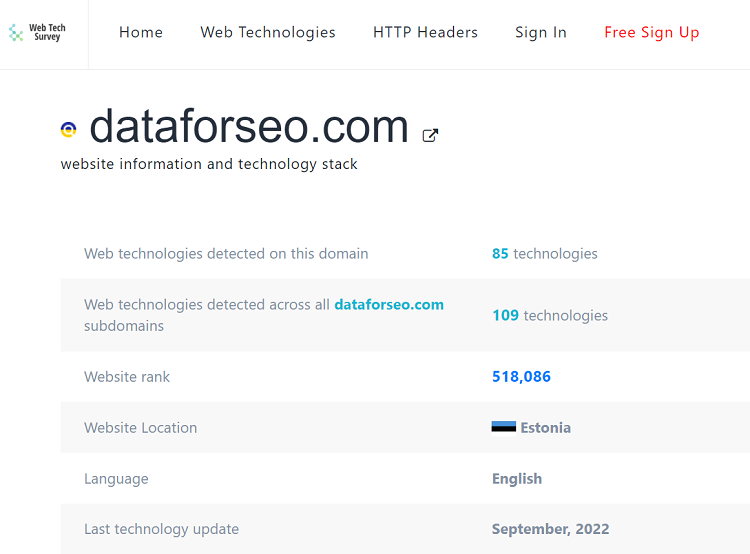
Below this table, users will find a website’s full tech stack information, the categories of each technology, and dates when they were detected by the technology profiler.
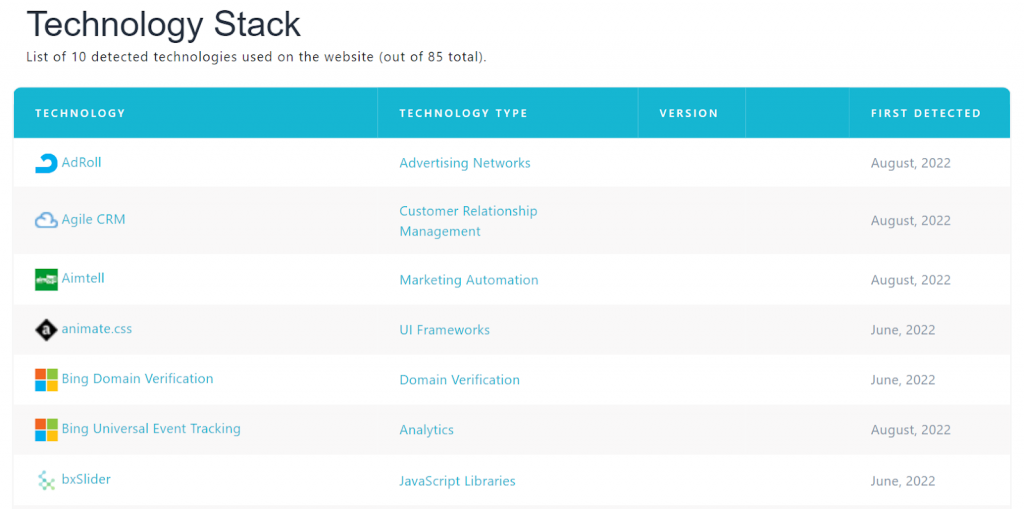
To obtain data for similar functionality with Technologies API, you should use the Domain Technologies endpoint. It will provide you with a comprehensive overview of all technologies found on the target site. On top of that, you will get additional data on a website, such as its meta title, description, country, languages, and keywords. Using this data, you can create an enhanced version of the tech stack view when building your tool.
Here’s an example request and response needed that can provide data for the functionality illustrated above.
[
{
"target": "dataforseo.com"
}
]
{
"version": "0.1.20220819",
"status_code": 20000,
"status_message": "Ok.",
"time": "1.3466 sec.",
"cost": 0.01,
"tasks_count": 1,
"tasks_error": 0,
"tasks": [
{
"id": "10261408-1535-0483-0000-792bc4e705d4",
"status_code": 20000,
"status_message": "Ok.",
"time": "1.2725 sec.",
"cost": 0.01,
"result_count": 1,
"path": [
"v3",
"domain_analytics",
"technologies",
"domain_technologies",
"live"
],
"data": {
"api": "domain_analytics",
"function": "domain_technologies",
"se": "technologies",
"target": "dataforseo.com"
},
"result": [
{
"type": "domain_technology_item",
"domain": "dataforseo.com",
"title": "Powerful API Stack For Data-Driven SEO Tools – DataForSEO",
"description": "We provide comprehensive data solutions for SEO and SEM analytics via API. DataForSEO is a trusted partner for 750+ SEO software companies and agencies.",
"meta_keywords": null,
"domain_rank": 456,
"last_visited": "2022-10-24 11:19:16 +00:00",
"country_iso_code": "EE",
"language_code": "en",
"content_language_code": "en",
"phone_numbers": [
"+3726027642"
],
"emails": [
"[email protected]"
],
"social_graph_urls": null,
"technologies": {
"servers": {
"cdn": [
"Cloudflare"
],
"performance": [
"EWWW Image Optimizer"
],
"databases": [
"MySQL"
]
},
"add_ons": {
"wordpress_plugins": [
"Contact Form 7",
"EWWW Image Optimizer",
"Responsive Lightbox & Gallery",
"Slider Revolution"
]
},
"location": {
"maps": [
"Google Maps"
]
},
"web_development": {
"javascript_libraries": [
"jQuery",
"jQuery Migrate",
"Lightbox",
"prettyPhoto",
"Underscore.js"
],
"programming_languages": [
"PHP"
]
},
"content": {
"photo_galleries": [
"Responsive Lightbox & Gallery"
],
"cms": [
"WordPress"
],
"blogs": [
"WordPress"
]
},
"media": {
"photo_galleries": [
"Responsive Lightbox & Gallery"
]
}
}
}
]
}
]
}
If you’d like to enrich your solution with whois data and backlink stats, you can also integrate our Whois API.
2. Technology overview features
In this part, our exploration will be based on the Wappalyzer functionality. We’re now performing a search with a technology name, such as Shopify.
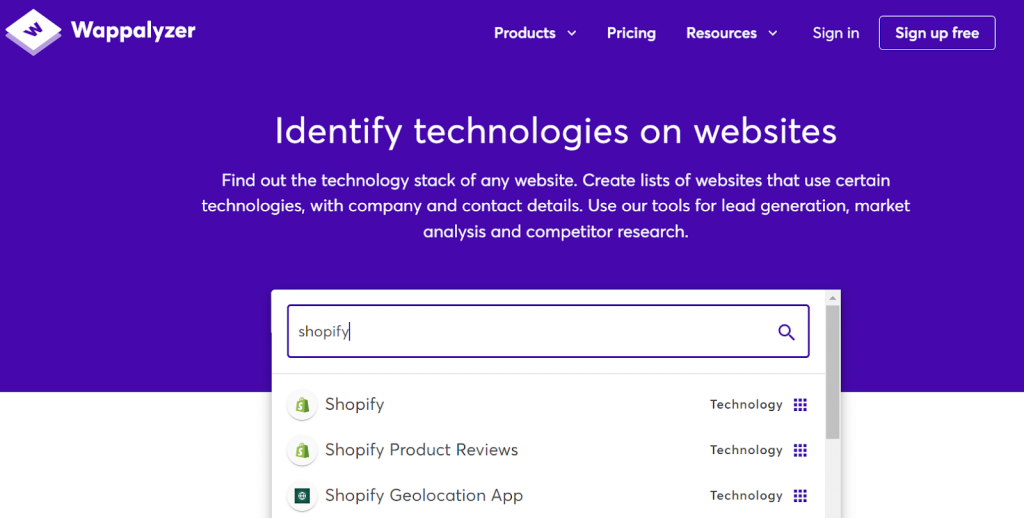
This brings us to the informational view for the indicated technology. Here, a user can find a list of top websites by traffic employing the target solution.
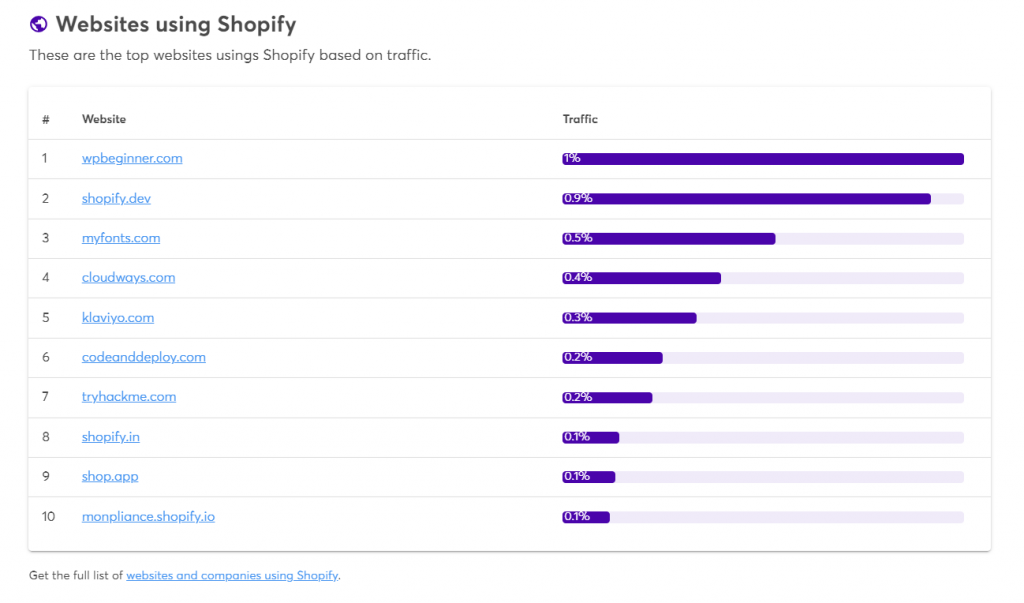
To implement this feature, use the Domains by Technology endpoint and specify Shopify as the technology name. Note that DataForSEO Technologies API does not supply traffic insights, however, you can sort the domains by their Domain Rank (based on DataForSEO Backlink Index) offered in the response.
Besides the tech stack data and the Domain Rank values, you will also receive each website’s title, description, meta keywords, country, language, phone numbers and emails, and more. Having this information, you will be able to provide your users with complete reports or lead lists that sales reps can use to contact the website owners.
You can find an example request and response below.
[
{
"technologies": [ "Shopify"],
"order_by": ["domain_rank,desc"],
"limit": 2
}
]
{
"version": "0.1.20220819",
"status_code": 20000,
"status_message": "Ok.",
"time": "1.4068 sec.",
"cost": 0.012,
"tasks_count": 1,
"tasks_error": 0,
"tasks": [
{
"id": "10261412-1535-0484-0000-00afaab143cc",
"status_code": 20000,
"status_message": "Ok.",
"time": "1.3310 sec.",
"cost": 0.012,
"result_count": 1,
"path": [
"v3",
"domain_analytics",
"technologies",
"domains_by_technology",
"live"
],
"data": {
"api": "domain_analytics",
"function": "domains_by_technology",
"se": "technologies",
"technologies": [
"Shopify"
],
"order_by": [
"domain_rank,desc"
],
"limit": 2
},
"result": [
{
"total_count": 727130,
"items_count": 2,
"offset": 0,
"offset_token": "eyJDdXJyZW50T2Zmc2V0IjoyLCJSYXdSZXF1ZXN0Ijp7Im9yZGVyX2J5Ijp7Im9yZGVyX2ZpZWxkIjoiZG9tYWluX3JhbmsiLCJvcmRlcl90eXBlIjoiZGVzYyJ9LCJsaW1pdCI6Miwib2Zmc2V0IjowLCJ0ZWNobm9sb2dpZXMiOlsiU2hvcGlmeSJdfSwiU2VhcmNoQWZ0ZXJEYXRhIjp7IlZlcnNpb24iOjEsIlNlYXJjaEFmdGVyVmFsdWVzIjp7ImRvbWFpbl9yYW5rIjoxNzc4MjA2OTIwMC4wLCJfc2NvcmUiOjYuMzcwODkxNiwiZG9tYWluX2hhc2giOi0zLjczMzk1Mjc2RSsxOH0sIlRva2VuUmVhbE9mZnNldCI6MH19",
"items": [
{
"type": "domain_technology_item",
"domain": "thegithubshop.com",
"title": "GitHub Shop | Shop the Pride 2022 Collection",
"description": "Celebrate your pride and show support this month with the all new GitHub Pride 2022 t-shirts and hoodies.",
"meta_keywords": null,
"domain_rank": 845,
"last_visited": "2022-10-21 06:04:14 +00:00",
"country_iso_code": "US",
"language_code": "en",
"content_language_code": "en",
"phone_numbers": null,
"emails": null,
"social_graph_urls": [
"https://thegithubshop.com/",
"@"
],
"technologies": {
"security": {
"security": [
"reCAPTCHA"
],
"ssl_tls_certificate_authorities": [
"AWS Certificate Manager"
]
},
"web_development": {
"ui_frameworks": [
"Bootstrap"
],
"javascript_libraries": [
"jQuery"
]
},
"sales": {
"ecommerce": [
"Shopify"
]
},
"servers": {
"cdn": [
"Cloudflare",
"cdnjs"
],
"paas": [
"Amazon Web Services"
]
}
}
},
{
"type": "domain_technology_item",
"domain": "hyperx.com",
"title": "HyperX | High Quality Gaming Gear\n\n \n\n \n\n \n\n \n – HyperX US",
"description": "HyperX is a brand committed to making sure every gamer feels they are included. No matter who you are, or what you play, WE'RE ALL GAMERS.",
"meta_keywords": null,
"domain_rank": 755,
"last_visited": "2022-10-25 05:05:27 +00:00",
"country_iso_code": "US",
"language_code": "en",
"content_language_code": "de",
"phone_numbers": null,
"emails": null,
"social_graph_urls": [
"https://twitter.com/hyperx",
"https://www.facebook.com/hyperxcommunity",
"https://www.instagram.com/hyperx/",
"https://www.youtube.com/c/hyperx"
],
"technologies": {
"analytics": {
"tag_managers": [
"Google Tag Manager"
],
"browser_fingerprinting": [
"MaxMind"
]
},
"servers": {
"cdn": [
"Cloudflare",
"cdnjs"
]
},
"location": {
"geolocation": [
"MaxMind"
]
},
"marketing": {
"marketing_automation": [
"Klaviyo"
]
},
"sales": {
"ecommerce": [
"Shopify"
]
}
}
}
]
}
]
}
]
}
The next feature we’ll review comes under the table with Shopify-powered websites and shows a distribution of Shopify customers by location and language.

This feature can be built atop the Technologies Summary endpoint. Simply specify the “Shopify” technology name, and the API response will provide you with the necessary stats.
In addition to the countries and languages of the sites built with the target technology, you will also get a distribution of the most popular keywords found on the indicated number of websites.
[
{
"technologies": [
"Shopify"
]
}
]
{
"version": "0.1.20220819",
"status_code": 20000,
"status_message": "Ok.",
"time": "2.7355 sec.",
"cost": 0.01,
"tasks_count": 1,
"tasks_error": 0,
"tasks": [
{
"id": "10261413-1535-0492-0000-e44f0bdd83e7",
"status_code": 20000,
"status_message": "Ok.",
"time": "1.4453 sec.",
"cost": 0.01,
"result_count": 1,
"path": [
"v3",
"domain_analytics",
"technologies",
"technologies_summary",
"live"
],
"data": {
"api": "domain_analytics",
"function": "technologies_summary",
"se": "technologies",
"technologies": [
"Shopify"
]
},
"result": [
{
"countries": {
"US": 231234,
"WW": 58865,
"GB": 36914,
"AU": 30376,
"CA": 26514,
"DE": 14503,
"FR": 12752,
"NZ": 7043,
"IN": 6990,
"IT": 6238
},
"languages": {
"en": 542179,
"fr": 19974,
"es": 19926,
"de": 17129,
"ja": 11382,
"it": 7216,
"pt": 5250,
"nl": 4873,
"": 2914,
"da": 2784
},
"content_languages": {
"en": 519005,
"de": 39968,
"fr": 21968,
"es": 18133,
"an": 12696,
"ro": 10663,
"ja": 8311,
"it": 7275,
"af": 6931,
"pt": 5577
},
"keywords": {
"Shopify Template": 3864,
"Minimal": 1247,
"Fastest": 1243,
"Lazyload": 1240,
"Ajax Shop": 1237,
"Kalles shopify": 728,
"Best Shopify Theme": 240,
"Electronics": 231,
"Fashion theme": 222,
"gecko shopify": 211
}
}
]
}
]
}
Another feature that some technology profilers offer in this report represents a list of technologies that are often used together. For example, BuiltWith provides the following summary of complementary technologies for Shopify.
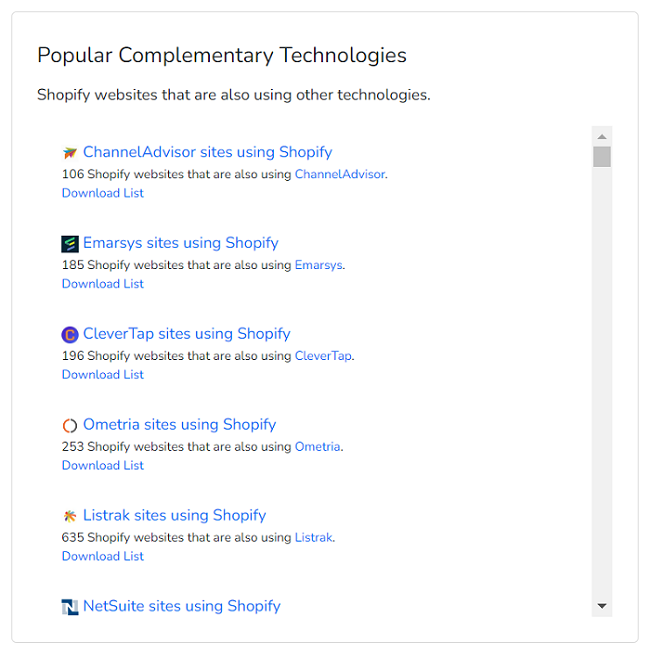
You can create this feature using the Aggregation Technologies endpoint. When making a request, specify the necessary technology name, and you’ll get a list of technologies often used together with your target solution. Here’s an example.
[
{
"technology": "Shopify",
"order_by": ["technologies_count,desc"],
"limit": 5
}
]
{
"version": "0.1.20220819",
"status_code": 20000,
"status_message": "Ok.",
"time": "1.4997 sec.",
"cost": 0.015,
"tasks_count": 1,
"tasks_error": 0,
"tasks": [
{
"id": "10261414-1535-0491-0000-e4a559a4b27b",
"status_code": 20000,
"status_message": "Ok.",
"time": "1.4303 sec.",
"cost": 0.015,
"result_count": 1,
"path": [
"v3",
"domain_analytics",
"technologies",
"aggregation_technologies",
"live"
],
"data": {
"api": "domain_analytics",
"function": "aggregation_technologies",
"se": "technologies",
"technology": "Shopify",
"order_by": [
"technologies_count,desc"
],
"limit": 5
},
"result": [
{
"total_count": 229,
"items_count": 5,
"offset": 0,
"items": [
{
"type": "aggregation_technologies_item",
"group": "sales",
"category": "ecommerce",
"technology": "Shopify",
"groups_count": 807998,
"categories_count": 730321,
"technologies_count": 727130
},
{
"type": "aggregation_technologies_item",
"group": "servers",
"category": "cdn",
"technology": "Cloudflare",
"groups_count": 1020557,
"categories_count": 920185,
"technologies_count": 723256
},
{
"type": "aggregation_technologies_item",
"group": "web_development",
"category": "javascript_libraries",
"technology": "jQuery",
"groups_count": 718854,
"categories_count": 506735,
"technologies_count": 287528
},
{
"type": "aggregation_technologies_item",
"group": "analytics",
"category": "analytics",
"technology": "Google Analytics",
"groups_count": 216464,
"categories_count": 172502,
"technologies_count": 168565
},
{
"type": "aggregation_technologies_item",
"group": "web_development",
"category": "javascript_libraries",
"technology": "Modernizr",
"groups_count": 718854,
"categories_count": 506735,
"technologies_count": 86119
}
]
}
]
}
]
}
We hope that after this quick walk-through, you understand that building your own technology profiler is not that difficult if you know where to find data for it.
Don’t hesitate to check our documentation and start testing and integrating DataForSEO Domain Technologies API. We also provide a free Sandbox for testing and configuring our APIs, and free integration assistance if necessary.
Conclusion
Leveraging comprehensive data on the web tech landscape and the technologies of an individual site, companies enhance operational efficiency and drive more conversions.
The most flexible way to obtain technographic insights is by buying API access from a third-party vendor. Technology lookup APIs allow for easy integration with in-house software or databases. Many companies use technology lookup APIs to build their own technology profiling tools, CMS detectors, and similar solutions.
With the Domain Technologies API from DataForSEO, you can gain reliable access to a growing pool of technographic insights and you won’t be limited in your use cases.
Using a group of DataForSEO products called Domain Analytics API, you can also obtain a powerful data combo that includes website tech stack information, Whois and backlink stats.
Feel free to learn more about our products in the documentation and try our APIs for free.

